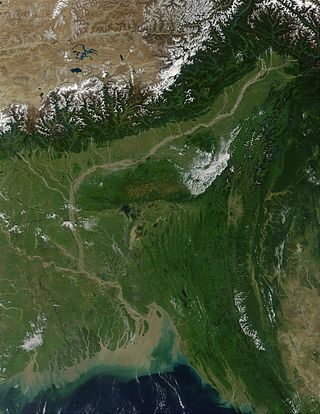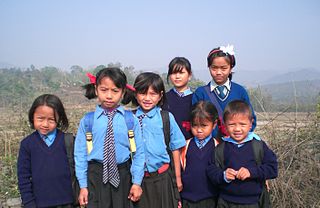Related Research Articles

Assam is a state in northeastern India, south of the eastern Himalayas along the Brahmaputra and Barak River valleys. Assam covers an area of 78,438 km2 (30,285 sq mi). It is the second largest state in northeastern India by area and the largest in terms of population. The state is bordered by Bhutan and Arunachal Pradesh to the north; Nagaland and Manipur to the east; Meghalaya, Tripura, Mizoram and Bangladesh to the south; and West Bengal to the west via the Siliguri Corridor, a 22-kilometre-wide (14 mi) strip of land that connects the state to the rest of India. Assamese and Boro are the official languages of Assam. Meitei (Manipuri) is the official language of Hojai district and the entirety of the Barak Valley districts, while Bengali is an official language in the three districts of Barak Valley.

Meitei, also known as Manipuri, is a Tibeto-Burman language of northeast India. It is the official language and the lingua franca of Manipur and one of the official languages of Assam. It is one of the constitutionally scheduled official languages of the Indian Republic. Meitei is the most widely-spoken Tibeto-Burman language of India and third most widely spoken language of northeast India after Assamese and Bengali. There are 1.76 million Meitei native speakers in India according to the 2011 census. Most of these, or 1.52 million, are found in the state of Manipur, where they represent majority of its population. There are smaller communities in neighbouring Indian states, such as Assam (168,000), Tripura (24,000), Nagaland (9,500), and elsewhere in the country (37,500). The language is also spoken by smaller groups in neighbouring Myanmar and Bangladesh.
Hmar is a Kuki ethnic group living in Northeast Indian state of Manipur, Mizoram, Assam and western Myanmar (Burma) and eastern Bangladesh. They use Meitei language as their second language (L2) in Manipur. They speak Mizo language as their L1 in Mizoram.

The Insurgency in Northeast India involves multiple separatist militant groups operating in some of India's northeastern states, which are connected to the rest of India by the Siliguri Corridor, a strip of land as narrow as 14.29 miles (23.00 km) wide.
The Hmar language belongs to the Mizo language branch of the Sino-Tibetan family of languages. The speakers of this language use Mizo language as their second language (L2).

West Garo Hills is an administrative district in Garo Hills of the state of Meghalaya in India. Tura town is the administrative headquarters of the district. The district occupies an area of 3714 km². In 2011, its population was 643,291. As of 2011, it is the second most populous district of Meghalaya, after East Khasi Hills.

Dima Hasao district, is an administrative district in the state of Assam, India. As of 2011, it is the least populous district of Assam.
DD Free Dish is an Indian free-to-air satellite television provider owned and operated by Public Service Broadcaster Prasar Bharati. It was launched in December, 2004. In March 2022, It has a reach of over 43 million households which is more than 25% of the total TV households in the country. DD Free Dish earns by selling slots to private broadcasters through Online auction.

Bodo–Kacharis is a name used by anthropologist and linguists to define a collection of ethnic groups living predominantly in the Northeast Indian states of Assam, Tripura, and Meghalaya. These peoples are speakers of either Bodo–Garo languages or Assamese. Some Tibeto-Burman speakers who live closely in and around the Brahmaputra valley, such as the Mising people and Karbi people, are not considered Bodo–Kachari. Many of these peoples have formed early states in the late Medieval era of Indian history and came under varying degrees of Sanskritisation.
Maibang is a town and a town area committee in Dima Hasao district in the Indian state of Assam. Maibang is also one of the three sub-divisions of Dima Hasao District. It was once the capital of the Dimasa Kachari Kingdom. There is a stone house of Dimasa king.

The Brahmaputra Valley is a region situated between hill ranges of the eastern and northeastern Himalayan range in Eastern India.

The People of Assam inhabit a multi-ethnic, multi-linguistic and multi-religious society. They speak languages that belong to four main language groups: Tibeto-Burman, Indo-Aryan, Tai-Kadai, and Austroasiatic. The large number of ethnic and linguistic groups, the population composition, and the peopling process in the state has led to it being called an "India in miniature".

The Board of Secondary Education, Rajasthan (RBSE) or(BSER) is a State Level board of education in the Indian state Rajasthan, for public and private schools, controlled and managed by the Government of Rajasthan. The board is responsible for promotion and development of secondary education in Rajasthan state. RBSE was Established in the year 1957 and constituted under the Rajasthan Secondary Education Act 1957.All schools affiliated to RBSE follow the NCERT curriculum especially from class 9 to 12. The current Chairperson of RBSE is Laxmi Narayan Mantri (IAS).
The Constitution of India categorizes the tribes of Assam into two groups: Scheduled Tribes (Hills) and Scheduled Tribes (Plains). Since hills tribes living in the plains and plains tribes living in the hills in large numbers are not recognised as scheduled tribes in the respective places, the census data may not reflect the correct figures. Assamese language is used as the lingua franca by almost all the tribes. According to the 2001 census, Scheduled Tribes made up 12.4 percent of Assam's population. The Assam Tribune reported in 2009 that the tribal communities of Assam were accounted for 15.64 percent of the total population.

The Ministry of Electronics and Information Technology (MEITy) is an executive agency of the Union Government of the Republic of India. It was carved out of the Ministry of Communications and Information Technology on 19 July 2016 as a standalone ministerial agency responsible for IT policy, strategy and development of the electronics industry. Under the sponsorship of the Ministry of Electronics and Information Technology, the "Northeast Heritage" Web, owned by the Government of India, publishes information on Northeast India, in 5 Indian languages, Assamese, Meitei (Manipuri), Bodo, Khasi and Mizo, in addition to Hindi and English.

The Assam Higher Secondary Education Council (AHSEC) is a state education regulatory board under the jurisdiction of Ministry of Education, Government of Assam that is responsible to regulate, supervise and develop the system of Higher Secondary Education in the State of Assam.
The Eighth Schedule to the Constitution of India lists nationally recognised regional languages of the Republic of India. At the time when the Constitution was enacted, inclusion in this list meant that the language was entitled to representation on the Official Languages Commission, and that the language would be one of the bases that would be drawn upon to enrich Hindi and English, the official languages of the Union. The list has since, however, acquired further significance. The Government of India is now under an obligation to take measures for the development of these languages, such that "they grow rapidly in richness and become effective means of communicating modern knowledge." In addition, candidates sitting for an examination conducted for public service are entitled to use any of these languages as a medium to answer the paper.
Debendra Green Grove English High School, abbreviated as DGGEHS, is a private co-educational high school in Monojuli, a village near to the town of Dhekiajuli in Sonitpur district, Assam, India. It is also known as Debendra Chandra Dey Memorial English School in memory of Debendra Chandra Dey, the father of the Principal.

The hill tribes of Northeast India are hill people, mostly classified as Scheduled Tribes (STs), who live in the Northeast India region. This region has the largest proportion of scheduled tribes in the country.
The population of Assam consist of tribal ethnic groups and linguistic groups such as Assamese, Bengali, Hindi speakers, Nepali and Odia speakers.
References
- ↑ "Assam HSLC Exam Routine 2023 Revised: SEBA To Conduct All Class 10 Language Papers Including English On April 1". India.com. 17 March 2023. Retrieved 19 March 2023.
In addition to Assamese, the other MIL subjects are Bengali, Bodo, Hindi, Manipuri, Hmar, Nepali, Mizo, Khasi, Garo, Karbi and Urdu.
- ↑ "Assam paper leak case: MIL exam of Class 10 boards rescheduled for April 1". Hindustan Times . 17 March 2023. Retrieved 19 March 2023.
The MIL paper includes languages such as English (IL), Assamese, Bengali, Bodo, Hindi, Manipuri, Hmar, Nepali, Mizo, Khasi, Garo, Karbi and Urdu.
- ↑ "Abiut us Board of secondary education council" . Retrieved 21 April 2023.